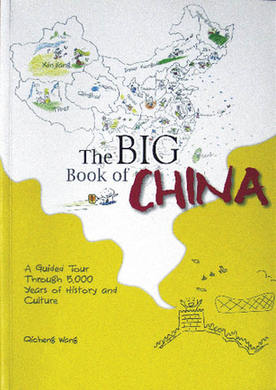The Big Book of China
The Big Book of China
By CAI LILI
|
 |
The Big Book of China By Wang Qicheng 224 pages, 220 illustrations RMB 99 in China, US $22.95 in North America Published in Beijing by the Foreign Language Press and in San Francisco by the Long River Press in 2010 |
It is not easy to introduce a country like China, which encompasses such vast diversity, beauty, history, and now, all the diversions of a burgeoning modernity. But this little book gives people the chance to explore its rich history and culture and learn, in bite-sized bits, more about the mysterious Middle Kingdom.
The author Wang Qicheng is a talented young illustrator, known as the “cartoon swordsman” in his circle. He once spent 10 years traveling extensively in China, sketching each interesting fragment he came across during his travels. These were published in 2007 under the title China Tour Guide: Cartoons.
The hero of this new book, Qi Qi, is a cute little boy with a curious mind. He is adept at telling his stories through his colorful crayon illustrations rather than burdening the reader with wordiness, and he sticks to unveiling only the highlights of this nation’s over 5,000-year history.
Qi Qi depicts China as a big rooster looking to the east. It stands on the western shores of the Pacific, far off across an ocean and half a world away from America. Over the rooster image, Qi Qi paints tiny figures dressed in various folk costumes, representing the 56 ethnic groups that make up China’s population.
The simplified time lines make it easy for Western readers to better understand China’s historical progress. It not only marks China’s big events, but also puts them in the context of those that simultaneously occurred in other parts of the world. A clear contrast: China experienced more than its share of wars and battles during the Spring and Autumn Period from 770 to 475 BC. During the middle part of this period, the Roman Republic was established. Perhaps you have never heard of those events or made these comparisons. If not, the book will do that for you.
Besides giving great insight to the basics of China from the point of view of its history, geography and population, The Big Book also focuses on the details of the everyday lives of Chinese folks. For instance, those who haven’t yet visited Beijing might be curious to learn about its famous hutongs and courtyard homes.
The courtyards often have elements like a large round earthen jar filled with goldfish, or a grape trellis to provide the elderly with shade during hot summer. One can imagine children and kittens that might regularly play here, while the voices of vendors hawking their wares sail over the walls from the nearby hutongs. Daily life is something so vivid that only illustrations, rather than words, could truly convey its subtle details.
The Big Book doesn’t confine itself to being a light panorama of China, but also provides for readers with special interests. From old to new this book steps outside of a conventional linear style to fully present Chinese history. It starts with China’s two major rivers – the Yangtze and the Yellow – that have nurtured this civilization for thousands of years, and remain prime influences over the nation’s economy and life. It covers Qinshihuang, the first emperor who united the country over 2,000 years ago, a name that may be unfamiliar to Western readers. But everyone surely has heard of the terracotta warriors of Xi’an, which were part of that emperor’s tomb. Ancient Chinese art is splendid, but today’s art is also cool. Formerly a wireless radio equipment factory, the 798 Art Zone is now one of the largest gallery zones in Beijing, a mecca to the country’s pioneering modern artists.
Who should buy an illustrated book? Comic illustrations have been an attractive way of reading since they were first used in England during the 18th century to criticize the politics of the day. Comic books may have been overshadowed in recent years by the Internet, but cartooning still survives among its loyal group of readers and has morphed into the lofty, arty graphic novel. Teenagers, who have grown up with computers, might also find joy in an illustrated book. Wang Qicheng’s illustrations are done using simple lines and color, creative inspiration and clever construction.
Readers can join Qi Qi on his joy-filled adventures through the incredible beauty of China’s rivers and mountains, savor the glory and brilliance of its fascinating culture, get a glimpse into the lives of everyday Chinese people, and even discover the secret formula for China’s magically flowering economy.
The Big Book of China is published in five languages, including Chinese, English, French, German and Spanish.
_____________________
CAI LILI is the editor of the book.
Services
Economy
- Eco-agriculture and Eco-tourism Power Nanchang’s Green Development
- Balance Environmental Protection and Economic Prosperity – Nanchang Looks to European Technology for Green Development
- Sustainable Growth Requires Wiser Energy Use
- Chinese Economy: On the Path of Scientific Development
- China's Economy over the Last Ten Years

